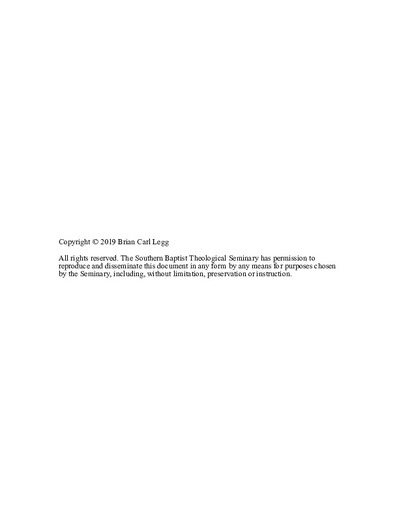| dc.contributor.advisor | Wilder, Michael S. | |
| dc.contributor.author | Legg, Brian C. | |
| dc.date.accessioned | 2019-11-20T19:03:56Z | |
| dc.date.available | 2019-11-20T19:03:56Z | |
| dc.date.issued | 2019-10-22 | |
| dc.identifier.uri | https://hdl.handle.net/10392/5974 | |
| dc.description.abstract | The numbers are alarming. Almost seventy-four percent of churches within the SBC are either in a state of plateau or decline. The church at large has a responsibility to reverse the trend and move the collective church body towards health. Now is the time to ask the hard questions about what leaders can do to reverse the trends of decline. The task of the church is to fulfill the Great Commission mandate. How can individual pastors and their churches meet this mandate and glorify God in their labor?
While revitalization is certainly a topic of interest among evangelical church leaders, with continuing efforts to create revitalization efforts such as the Mathena Center at SBTS or the Center for Church Revitalization at SWBTS, most of the research in the field is already dated or merely anecdotal. For these reasons this research was started in an effort to capture current empirical-based practices and principles to share with dying churches to revitalize.
This study utilized an explanatory sequential mixed-methods research design to identify successful church revitalizations and determine what influence transforming the discipleship culture had on those successes. In the quantitative phase of this research 716 (5.24 percent) of SBC churches who had experienced decline or plateau from 2006-2016 were found to have experienced revitalization. These churches were contacted for survey, and 145 church leaders responded by completing the survey instrument. Of the pastors surveyed, 77.38 percent indicated discipleship as “Important” or “Highly Important” in the revitalization process. Selection criteria were applied to identify churches to participate in the qualitative phase.
In the qualitative phase twelve in-depth interviews were conducted to identify best practices among pastors who have led their churches through changing their discipleship culture in revitalization. The top three practices included: (1) changes related to small group ministry, (2) relying on Scriptural authority for organizational changes, and (3) leveraging a new member assimilation process. Discerning these “best practices” not only has application for dying and plateaued churches, but also for growing churches to maintain church health. | en_US |
| dc.subject.lcsh | Discipling (Christianity) | en_US |
| dc.subject.lcsh | Church renewal | en_US |
| dc.title | Transforming The Discipleship Culture In Church Revitalization: A Mixed-Methods Study | en_US |
| dc.type | Electronic dissertation | en_US |
| dc.type | Text | |
| dc.contributor.committee | Parker, Shane W. | |
| dc.type.qualificationname | Ed.D. | en_US |
| dc.publisher.institution | Southern Baptist Theological Seminary | en_US |
| dc.publisher.department | School of Missions and Evangelism | |

